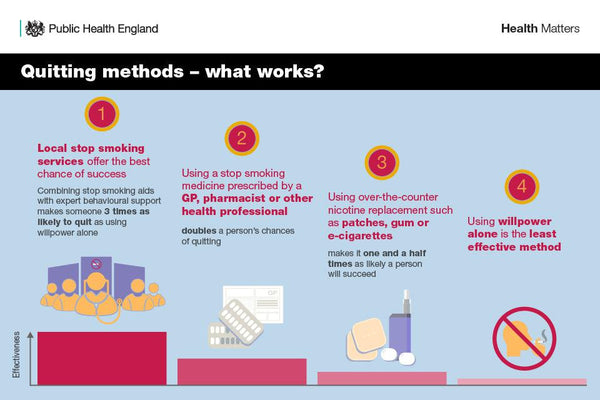Last fact-checked 28 February 2024 | Report a content error
Here in the UK, smoking is still one of our biggest public health problems. In the 2022-2023 year alone, cigarettes accounted for 74,600 deaths and 408,700 hospitals in England (source: nhs.uk). With stats like these, any quitting tool that can help more smokers quit deserves our full support.
But what do the NHS have to say about vaping as a quitting strategy? What’s the official UK position on e-cigarettes, and what evidence is there that e-cigarettes really are helping to turn the tide on tobacco?
In this article, we’ll walk you through the latest guidance from the NHS on vaping, and show you some interesting research from other government departments and British medical groups.
Does the NHS recommend vaping for quitters?
The NHS states that people who use "... e-cigarettes to quit smoking, as well as having expert face-to-face support, can be up to twice as likely to succeed as people who used other nicotine replacement products, such as patches or gum". It also warns that you need the right nicotine levels in your vape juice, and you need to stop smoking completely, if you want vaping to work for you (source: nhs.uk).
At the moment, you can't get vapes on prescription from the NHS, but this may change in the near future. The Government have announced plans to invest £45 million in a 'Swap to Stop' programme as part of its smoke-free strategy (read 'Stopping the start: what the latest anti-smoking plans mean for vapers' to learn more).
Public Health England recently announced that quitters who combine stop smoking aids with “expert behavioural support” are 3 times more likely to quit than someone using willpower alone (source: gov.uk).

Is Vaping a safe way to quit cigarettes?
We still need more research into the long-term effects of vaping, but based on the research that has been done so far, vaping is much safer and much healthier than smoking. In an interview with the British Heart Foundation, Public Health England’s Martin Dockrell summed it up perfectly:
“We know that e-cigarettes are probably not completely safe, but that’s not the issue. The question is, are e-cigarettes safer than the alternative? It's really important that smokers understand how much safer e-cigarettes are, compared to smoking".
- Martin Dockrell, Tobacco Control Programme Lead at Public Health England
What makes e-cigarettes safer than smoking?
Unlike cigarette smoke, e-liquid vapour doesn’t contain tar or carbon monoxide. By switching from tobacco to e-liquid, quitters still get the sensation they associate with smoking, but they stop these two lethal compounds from entering their bodies.
What’s in a normal cigarette?
If you want to see the tar and other chemicals in cigarette smoke for yourself, take a look at this short video on the NHS website:
In the video, Dr Rosemary Leonard MBE & Dr Lion Shahab start out with two identical glass bell jars filled with cotton wool. They pump e-cigarette vapour through one jar, and cigarette smoke through the other, and they use the cotton wool to show us what our lungs are probably dealing with when we smoke or vape.
The jar with cigarette smoke is soon full of grime and tar - it’s shocking.
Are E-Cigarettes Helping British Smokers Quit?
The latest report from Public Health England shows that 1.2 million Brits have used e-cigarettes to successfully quit tobacco. Just take a look at the infographic below (source: gov.uk):
Aren’t UK smoking rates already in decline?
Smoking prevalence (the percentage of the population who smoke) has been declining in the UK for decades. So can we really say that e-cigarettes are driving down smoking rates?
Based on the UK smoking stats before and after 2012, we’re pretty confident that e-cigarettes are making a substantial contribution to our smoking rates.
According to the Office of National Statistics (ONS), 50 years ago, a whopping 45% of British people over the age of 16 were smokers. That percentage fell steadily by nearly 1% per year for the next 20 years, but by the mid-2000s, smoking rates had levelled out at about 20%.
By 2007, 21% of British people aged 16 or older were classed as smokers. That same year, the UK Government banned smoking in enclosed spaces and changed the age limit on tobacco from 16 to 18. You might think that these new laws would have pushed our smoking rate down, but they had no real effect whatsoever. In fact, according to the ONS, “from 2007 to 2012 the rate of smoking remained largely unchanged” (source: nationalarchives.gov.uk).
Then, in 2012, the popularity of e-cigarettes skyrocketed. Britain’s smoking prevalence rate, which had been stuck in the mud at 20% for half a decade, suddenly began to fall again.
In an October 2023 report, the government announced that "Smoking rates in the UK are now the lowest on record, at 12.9% (around 6.4 million people)". We can’t conclusively prove that e-cigarettes were the sole cause for this sudden change in Britain’s quitting rates, but it's highly likely that the rise in e-cigs and the fall in smoking rates are linked.
About the NHS Stop Smoking Service
At Gourmet eLiquid, we’re ex-smokers ourselves, so we know what you’re going to go through when you try to quit. However you choose to quit, our advice is to take all the help you can get, and remember the research: ‘willpower alone’ is literally the least effective way to quit cigarettes (source: gov.uk).
You can find your local NHS stop smoking service at the link below:
https://www.nhs.uk/better-health/quit-smoking/find-your-local-stop-smoking-service/
We hope this article has shone some light on the official NHS position on e-cigarettes. If you have any other questions you would like us to answer, either about vaping in general or any of the products we sell, please get in touch.
Sincerely wishing you the very best of luck on your quitting journey.
John Boughey


